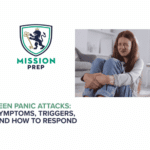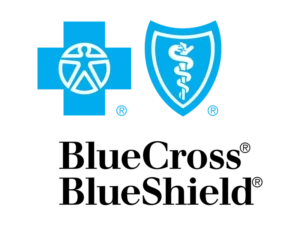Panic Attack Intervention Tips for Teens: Coping Strategies for Teen Anxiety & Panic

Your heart’s pounding, your throat is tightening, and the walls feel as though they’re closing in. It’s overwhelming and scary. Whether you’re a teen experiencing this or a parent watching it happen to your child, panic attacks can be intensely frightening and confusing.
Panic attacks are more common than you may think: more than two in every hundred adolescents have panic disorder in the U.S.1 Recognizing panic attack signs in youth is often the first step toward getting the right help for your child.
This page serves as an adolescent panic intervention guide. You’ll find practical, compassionate support for teens trying to manage anxiety and panic, and also for parents and caregivers who want to help. If you’re looking for panic attack help for teens, coping techniques, or want to create a long-term plan to manage episodes, we’ve got you covered.
Professional support is encouraged if panic attacks are impacting your daily life. However, this page can also help by exploring:
- Recognizing panic signs in youth
- Immediate panic attack help for teens
- Calming techniques for panic attacks
- Emotional regulation for teens after panic episodes
- Youth anxiety intervention and long-term recovery
- Finding professional support for panic attacks

Recognizing Panic Signs in Youth
Panic disorder is relatively common, with over three million Americans experiencing it at some point during their life.2 It often starts during the teen years, and is, fortunately, treatable. But to be able to treat it, you first need to recognize the symptoms.
Symptoms of Panic Attacks in Adolescents
Having a panic attack can be extremely scary. They can come out of the blue and feel so overwhelming that some people think they’re having a heart attack. Yet, although a panic attack can be very uncomfortable and alarming, it doesn’t cause you any physical harm. However, they can become a frequent occurrence – a panic disorder.
Some of the most common symptoms of a panic attack in teenagers include:2
- Feeling scared, as though something terrible is happening
- A racing or pounding heart
- Dizziness
- Shortness of breath
- Shaking
- Feeling as though things aren’t real
- Fears of losing control, going “crazy”, or dying
Panic Attack vs. Anxiety Episode
If you think that panic attacks and anxiety attacks are the same, think again. They have certain things in common, but are also very different.
Both panic and anxiety attacks feel very intense and often come with a host of physical symptoms, such as a pounding heart, shortness of breath, and trembling. You may feel detached from your surroundings, have racing thoughts, and feel like you need to escape the situation. It’s like an alarm goes off in your head, and your fight-or-flight response kicks in.3
However, there are some key differences between panic and anxiety episodes. Panic attacks tend to come on very quickly and seem to come out of nowhere, lasting up to half an hour at their worst intensity. You may feel a sense of dread or fear that you are losing control. Often, they don’t have an obvious “trigger.” Anxiety episodes, on the other hand, tend to build gradually over time and can last for hours or days. They feel less intense than a panic attack and are usually triggered by something stressful.
If you can relate to the symptoms of a panic attack, please know that support is available. The following information covers what helps during a panic attack.
Immediate Panic Attack Help for Teens
Fight-or-flight is a natural teenage stress response.4 But, if it kicks in too often or when there isn’t actual danger, it can become a problem. So, what can you do when a panic attack begins? If you’re wondering how to stop panic attacks in teenagers quickly, the next few sections can help.
Intervention Plan for Panic Attacks
When experiencing a panic attack, you may not be able to think as clearly as normal. This is where an intervention plan comes in. Having a step-by-step guide, whether on a piece of paper or in a notes app on your phone, can help guide you through panic. We’ve outlined some of the basic steps below.
It might be a good idea to bookmark this page so that you have it ready for when panic hits, or use it to create your own plan for when you need it the most.
- Step 1: Recognize that you are experiencing a panic attack
- Step 2: Remind yourself that you are not in any danger from a panic attack – it cannot harm you. It’s a false alarm from the danger alert system in your brain
- Step 3: Stay where you are (if it is a safe place). There is no need to escape if you are in a safe place
- Step 4: Do a deep breathing exercise to reduce your physical symptoms
- Step 5: Carry out a grounding technique to bring you back to the present moment
- Step 6: Remind yourself that panic attacks are temporary and will pass
We’ll dive into some of the most effective breathing exercises and grounding techniques for panic attacks in the next section.
Calming Techniques for Panic Attacks
Breathing exercises and grounding techniques for panic attacks can help you feel more in control when things seem like they’re spiralling. They can act as an anchor, bringing you back to the present moment and instilling a sense of safety. They may form an essential part of your calming toolkit, so remember to include them in your panic attack plan.
Breathing Tips for Panic Episodes
Breathing exercises can send a signal to your brain and trigger a calming response, which is invaluable during panic attacks.5 Two great breathing exercises to use are:
- Box Breathing: This slows down your breathing, telling your body you’re safe. It’s called “box breathing” because you split your breathing into four equal parts:
- Breathe in slowly through your nose for a count of four
- Hold your breath for four seconds
- Breathe out completely for a count of four
- Pause for four seconds
Then, repeat each step until you feel more relaxed.
- Extended Exhale Breathing: This type of breathing, known as the “4-7-8 breathing technique,” reduces anxiety.6 The focus is on taking slow, deep breaths in and out to regulate emotions. Here’s how to do it:
- Breathe in through your nose for four seconds
- Hold your breath for a count of seven
- Exhale completely for eight seconds
Repeat the above a couple of times until you feel calmer.
Grounding Techniques for Teens
Grounding techniques can help pull your attention away from panic and allow you to focus on the present moment.7 The following are two grounding techniques you could use to help anchor yourself during a panic attack:
- 5-4-3-2-1 technique: This method is all about engaging your senses: sight, touch, sound, smell, and taste, to pull your attention back to the present.8 Here’s how you can practice it. Focus on:
- Naming five things you can see
- Listing four things you can feel
- Finding three things you can hear
- Identifying two things you can smell
- Naming one thing you can taste
- Anchoring phrases: Affirmations can be repeated as a way to anchor yourself in the present moment and help you feel calmer. For instance, you could choose to repeat a specific word or phrase when you feel panicked, such as:
- Calm
- I am safe
- This moment will pass
Emotional Regulation for Teens After Panic Attacks
Having a panic attack can leave you feeling shaken. Learning how to manage your emotions, known as “emotional regulation,” can help you feel calmer and more in control in the aftermath. It’s an important skill to master, and could come in useful throughout your entire life.
Teen panic episode recovery can make a difference in how you move forward. There are certain things you can do immediately after a panic attack to support your mental health and well-being, including:
- Being kind to yourself: Acknowledge that you’ve had a panic attack. It’s a medical issue, not a weakness, and it can be treated
- Boosting yourself up: Remind yourself that although it might have felt awful, you survived it in one piece
- Remember the facts: Panic attacks are a false alarm going off in your head. They can’t really hurt you
- Practice mindfulness: Spend some time noticing how your body feels now that you are calmer
- Reframe your thoughts: Did you have any negative thoughts during your panic attack? Now that you are out of the panic zone, can you put a different spin on them?
- Consider triggers: Did anything happen before the panic attack that could have been a stress trigger? Self-awareness is key when battling panic and anxiety.
We’ve explored what to do immediately during and after a panic attack, but what can you do long-term to support your recovery? We’ll walk you through this next.
Youth Anxiety Intervention and Long-Term Recovery
If your teen is struggling with repeated panic attacks, you may want to consider what can be done long-term to help them overcome anxiety and panic disorder. Certain factors play a part in long-term recovery from panic attacks, which we explore below.
Forging a Recovery Mindset
Recovery from panic attacks isn’t something that happens overnight. Managing teen anxiety episodes is a process of growth and will take some time. It’s important to be patient and kind as you go on your healing journey. There’s no shame in having a mental health challenge. And remember to celebrate all of your wins – big or small – along the way.
Building Resilience and Coping Skills
As around 8% of children and teenagers experience an anxiety disorder, it’s useful to have panic attack coping strategies like those discussed earlier.9 There are also things you can do daily to improve your overall well-being that can have a knock-on effect on panic attacks. For instance, getting enough sleep, eating a nutritious diet, and exercising can all positively affect mental health. Coping strategies such as mindfulness and journaling may also improve symptoms of anxiety.10,11 Check out our pages below for more information:
Seeking Professional Support
If your teen is having panic attacks or has been diagnosed with panic disorder, psychotherapy is a very effective treatment. Talking therapies, such as cognitive behavioral therapy (CBT) and exposure therapy, can allow your child to understand their condition and get to the root of the problem. They also help them identify triggers and make practical changes to improve their life.
A doctor may also prescribe an anti-anxiety medication to treat and prevent panic attacks alongside therapy.
Strengthening Family Support
Support from family members can go a long way in helping a teen recover and feel understood. Educate yourself about panic attacks, and be a calm presence for your child. Try not to dismiss their feelings or judge them – they’re doing the best they can with their current knowledge. Acknowledge how they’re feeling and support them.

Finding Professional Support for Panic Attacks With Mission Prep
Panic attacks can feel overwhelming, but they can also be managed effectively with the right tools, support, and understanding. Whether you’re a teen trying to understand your anxiety or a parent wanting to help your child, know that you’re not alone, and things can get better.
If your teen is struggling with panic episodes, it may be time to seek professional support. At Mission Prep, our team of experts specializes in treating teenagers struggling with mental health challenges. Through our individualized treatment plans, we can help your teen to recover and grow with guidance, education, and evidence-based therapy.
Reach out today to find out more about our adolescent mental health programs and how we can help your family take the next step on the road to a calmer tomorrow.
References
- National Institute of Mental Health (NIMH). (n.d.). Panic disorder. Retrieved July 25, 2025, from https://www.nimh.nih.gov/health/statistics/panic-disorder
- American Academy of Child & Adolescent Psychiatry (AACAP). (n.d.). Panic disorder in children and adolescents. Retrieved July 25, 2020, from https://www.aacap.org/AACAP/Families_and_Youth/Facts_for_Families/FFF-Guide/Panic-Disorder-In-Children-And-Adolescents-050.aspx
- Calm Editorial Team. (2025, April 8). Panic attack vs. anxiety attack? Here’s the difference. Calm. https://www.calm.com/blog/panic-attack-vs-anxiety-attack
- Harvard Health. (2024, April 3). Understanding the stress response. https://www.health.harvard.edu/staying-healthy/understanding-the-stress-response
- Zaccaro, A., Piarulli, A., Laurino, M., Garbella, E., Menicucci, D., Neri, B., & Gemignani, A. (2018). How Breath-Control Can Change Your Life: A systematic review on Psycho-Physiological correlates of slow breathing. Frontiers in Human Neuroscience, 12. https://doi.org/10.3389/fnhum.2018.00353
- Aktaş, G. K., & İlgin, V. E. (2022). The effect of deep breathing exercise and 4–7-8 breathing techniques applied to patients after bariatric surgery on anxiety and quality of life. Obesity Surgery, 33(3), 920–929. https://doi.org/10.1007/s11695-022-06405-1
- Raypole, C. (2025, February 20). 30 Grounding techniques to quiet distressing thoughts. Healthline. https://www.healthline.com/health/grounding-techniques
- Psychological & Counseling Services. (2023, February 14). What is grounding? https://www.unh.edu/pacs/what-grounding
- Katzenstein, J. (2024, May 22). Anxiety and Stress in Teens. Johns Hopkins Medicine. https://www.hopkinsmedicine.org/health/conditions-and-diseases/anxiety-disorders/anxiety-and-stress-in-teens
- Khoury, B., Lecomte, T., Fortin, G., Masse, M., Therien, P., Bouchard, V., Chapleau, M., Paquin, K., & Hofmann, S. G. (2013). Mindfulness-based therapy: A comprehensive meta-analysis. Clinical Psychology Review, 33(6), 763-771. https://doi.org/10.1016/j.cpr.2013.05.005
- Tee-Melegrito, R. A. (2022, February 25). How to journal for anxiety. Medical News Today. https://www.medicalnewstoday.com/articles/how-to-journal-for-anxiety



















